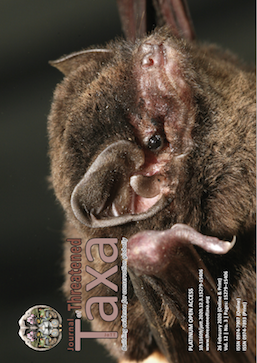Building walls around open wells prevent Asiatic Lion Panthera leo persica (Mammalia: Carnivora: Felidae) mortality in the Gir Lion Landscape, Gujarat, India
Main Article Content
Abstract
The Asiatic Lion population has increased in the last three decades, which now occupies a large regional spread with six or more identified satellite populations in eight districts of Gujarat. An overlap of lion habitat with human-dominated landscape elements leads to an increase in lion-human interactions in these growing satellite populations. A high rate of lion mortality has been observed in the periphery of Gir in the last decade due to falls into open dug wells. These wells have been excavated for irrigation in the agricultural landscape of Gir. About 145 wild animals including lions have died due to accidental falls into open wells in past 10 years. It has been observed that construction of parapet walls around wells in some of the peripheral areas of Gir Sanctuary have prevented this accidental mortality at very low cost. To assess the efficiency of these measures we did a survey of 20 random villages in the Gir Lion Landscape to collect data on the types of wells that cause this uncalled-for mortality. The paper explores the reasons for the lions falling into wells in the agricultural areas outside the Gir Sanctuary. The survey has shown that the corridors used by lions and in the satellite population areas are high risk sites where more parapet walls should be built on a priority basis. From the year 2007 to 2018 more than 48,000 parapet walls have already been randomly built in the periphery of the Gir Sanctuary. Out of 130 identified wells, 90 were protected with parapet wall or iron net while, 32 were without parapet wall and rest eight were with unfinished parapet wall. Providing a scheme for building more parapet walls around prioritized open wells would be an effective step towards Asiatic Lion conservation in the Gir Lion Landscape. Our survey indicates that there has been no mortality of lions in those wells where parapet walls have been built.
Article Details
Authors own the copyright to the articles published in JoTT. This is indicated explicitly in each publication. The authors grant permission to the publisher Wildlife Information Liaison Development (WILD) Society to publish the article in the Journal of Threatened Taxa. The authors recognize WILD as the original publisher, and to sell hard copies of the Journal and article to any buyer. JoTT is registered under the Creative Commons Attribution 4.0 International License (CC BY), which allows authors to retain copyright ownership. Under this license the authors allow anyone to download, cite, use the data, modify, reprint, copy and distribute provided the authors and source of publication are credited through appropriate citations (e.g., Son et al. (2016). Bats (Mammalia: Chiroptera) of the southeastern Truong Son Mountains, Quang Ngai Province, Vietnam. Journal of Threatened Taxa 8(7): 8953–8969. https://doi.org/10.11609/jott.2785.8.7.8953-8969). Users of the data do not require specific permission from the authors or the publisher.
References
Banerjee, K. & Y.V. Jhala (2012). Demographic parameters of endangered Asiatic lions (Panthera leo persica) in Gir Forests, India. Journal of Mammalogy, Oxford academic, Volume 93, Issue 6, 17 December 2012, Pages 1420–1430. https://doi.org/10.1644/11-MAMM-A-231.1 DOI: https://doi.org/10.1644/11-MAMM-A-231.1
Basu, P., Jhala, Y. V., & Qureshi, Q. (2012). Assessment of the future of potential dispersal corridors of Asiatic Lions (Panthera leo persica) across the agropastoral landscape between Gir & Girnar Wildlife Sanctuary. India Geospatial Forum. 14t Annual International Conference and Exhibition on Geospatial Information Tecnology and Applications. Paper Reference Number: PN-40 http://indiageospatialforum.org/2012/proceedings/ppt/Parabitafullpaper.pdf
Bharucha, E. (2017). Changing Landscapes: The Cultural Ecology of India (1 edition). HarperCollins, Noida, Uttar Pradesh, India, 400pp.
Dolrenry, S., J. Stenglein, L. Hazzah, R.S. Lutz & L. Frank (2014). A metapopulation approach to African lion (Panthera leo) conservation. PloS One 9(2): e88081. https://doi.org/10.1371/journal.pone.0088081 DOI: https://doi.org/10.1371/journal.pone.0088081
Gujarat Forest Department (2015). 14th Lion Population Estimation Report– 2015 (p. 14). http://gujenvis.nic.in/PDF/lion%20population%20report%202015.pdf
Jhala, Y.V., S. Mukherjee, N. Shah, K.S. Chauhan, C.V. Dave, V. Meena & K. Banerjee (2009). Home range and habitat preference of female lions (Panthera leo persica) in Gir forests, India. Biodiversity and Conservation. 18. 3383–3394. https://doi.org/10.1007/s10531-009-9648-9 DOI: https://doi.org/10.1007/s10531-009-9648-9
Kumar, S., & M. Pathan (2015). The Majestic Lions of Gir (First Edition). R.R. Sheth & Co. Pvt. Ltd., Ahmadabad, 368pp.
Kumar, S. & M. Pathan (2018). Jewels of Gir. R R Sheth & Co. Pvt. Ltd., Ahmadabad, 312pp.
Meena, V., D.W. Macdonald & R.A. Montgomery (2014).Managing success: Asiatic lion conservation, interface problems and peoples’ perceptions in the Gir Protected Area. Biological Conservation 174: 120–126. https://doi.org/10.1016/j.biocon.2014.03.025 DOI: https://doi.org/10.1016/j.biocon.2014.03.025
Ministry of Environment, Forest and Climate Change Government of India (2017). ESZ Notifications. http://www.moef.nic.in/content/esz-notifications
Pathak, N., & Kothari, A. (2013). Role of Local People and Community Conservation in Rajasthan, 285–297. In: Sharma, B., S. Kulshreshtha & A. Rahmani (eds.). Faunal Heritage of Rajasthan, India. Springer, Cham. https://doi.org/10.1007/978-3-319-01345-9_14 DOI: https://doi.org/10.1007/978-3-319-01345-9_14
Pati, B.P. & S. Vijayan (2002). Cub Mortality in Asiatic Lions (Panthera leo persica) in Gir Sanctuary and National Park , Gujarat : a Cause for Population Stabilization ? Indian Forester, 128(10), 1159-1161–1161.
Rodgers, W.A. & H.S. Panwar (1988). Planning wildlife protected area network in India. Volume I - The Report: A report prepared for the Department of Environment, Forest & Wildlife, Government of India at Wildlife Institute of India. Wildlife Institute of India, March 1988, 50pp.
Singh, S. (2000). Gir Lion- Present scenario and Future Conservation Stratagy. http://www.catsg.org/fileadmin/filesharing/3.Conservation_Center/3.4._Strategies___Action_Plans/Asiatic_lion/Singh_2000_Gir_lion_status_and_conservation.pdf
Singh, S. (2017). Dispersion of the Asiatic Lion Panthera leo persica and its Survival in Human-Dominated Landscape Outside the Gir Forest, Gujarat, India. Current Science 112(05): 933–940. https://doi.org/10.18520/cs/v112/i05/933-940 DOI: https://doi.org/10.18520/cs/v112/i05/933-940
Shankar, U. (2017). Protection of wildlife outside protected areas: With reference to desert districts of Rajasthan. http://www.teriuniversity.ac.in/mct/pdf/assignment/uday_shankar.pdf

